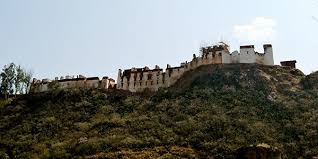Of lost glories and silent prayers
A reminiscence of a Wangduephodrang Dzong (fortress) that once stood perched on the hillock. Save for the memories, everything is history now.

The inferno has ebbed and the appalling smell of burnt mud and wood fills the air, and all that remains are traces of charred wood and reminiscence of a fortress that once stood perched on the hillock. Save for the memories, everything is history now.
Seated on a knoll overlooking the fortress in ruins is 72-year old aap Doley from Shar Samtengang. He is watching the men in uniforms and their likes scavenging the ashy remains at the site, to retrieve anything of value. It’s been raining the entire night and the ground is wet, yet aap Doley is least bothered.
It’s almost eight in the morning but the sky is overcast with clouds and the glory of the sun is yet to greet the valley, and to add to the misery it starts to drizzle again, but aap Doley, with a rosary in his hands won’t budge an inch. A closer scrutiny at him tells me he’s lost in thoughts—his hands folded in prayers and the grief in his wrinkled face unmistakable.
Aap Doley has, in his 72 years of stay in this quaint old valley, has never seen a disaster of this magnitude. “I am lost for words,” he says as he breaks down. “I have spent my entire life in this place, never missed the annual tshechus and now everything is gone in a blink of an eye. I wish this was just a nightmare.”
Its past day three since the disaster struck and aap Doley has come all the way from his village after he heard that the dzong was completely razed to the ground. “I never knew and dreamt that I would live to see this day. All I can do is stare helpless and pray,” the 72-year old says, adding this is the worst thing that he has witnessed in his entire life—a dictum that’s more than apparent in this tale.
As he caresses his wrinkled fingers and make rounds on his equally time tested rosary, ap Doley says he fondly remember the days when he and the communities of Shar dha gye, eight provinces of the Shar valley, came together to celebrate the annual domchhoe. After a year of toiling in their fields it was time to celebrate then. “I have never missed the festivals but now am doubtful if I will ever live to see this again. My only wish is that I will live to see the dzong rebuilt to its original glory and attend the festival, at least for once, before I leave this world.”
Meanwhile, the scene inside the dzong has gone quieter. A group of people, probably the business community, is busy serving drinks and refreshments to the volunteers and all those who had come to play their part to help find any valuables from the remnants. In a corner, just across us, is a group of giggling teenagers flashing their mobiles phones and cameras to capture what is left of a history, lost.
It’s almost half past ten now and the crowd is gathering strength while little plumes of smoke still hovers around the air. Aap Doley has been standing there since seven in the morning and, for the last time he folds his hands again and gets back to his prayers.
The silence is broken after a convoy of cars and important looking men and their aides arrive at the scene. The paparazzis’ and all the men equipped with their notepads, pens and flashy cameras rush to the scene. I stay put to ask him one last question. “Apa if I were to narrate one important thing about this dzong to my children long after you are gone what would that be?” He stares back at me as tears build up in his eyes, stays silent for a while and then gets back to his prayers.
I have found my answer, there’s no word to describe the loss, yet aap Doley’s tear-filled eyes says it all.




